Md Kamrul Hasan
Ehsan
PhysicsEval: Inference-Time Techniques to Improve the Reasoning Proficiency of Large Language Models on Physics Problems
Jul 31, 2025Abstract:The discipline of physics stands as a cornerstone of human intellect, driving the evolution of technology and deepening our understanding of the fundamental principles of the cosmos. Contemporary literature includes some works centered on the task of solving physics problems - a crucial domain of natural language reasoning. In this paper, we evaluate the performance of frontier LLMs in solving physics problems, both mathematical and descriptive. We also employ a plethora of inference-time techniques and agentic frameworks to improve the performance of the models. This includes the verification of proposed solutions in a cumulative fashion by other, smaller LLM agents, and we perform a comparative analysis of the performance that the techniques entail. There are significant improvements when the multi-agent framework is applied to problems that the models initially perform poorly on. Furthermore, we introduce a new evaluation benchmark for physics problems, ${\rm P{\small HYSICS}E{\small VAL}}$, consisting of 19,609 problems sourced from various physics textbooks and their corresponding correct solutions scraped from physics forums and educational websites. Our code and data are publicly available at https://github.com/areebuzair/PhysicsEval.
BdSLW401: Transformer-Based Word-Level Bangla Sign Language Recognition Using Relative Quantization Encoding (RQE)
Mar 04, 2025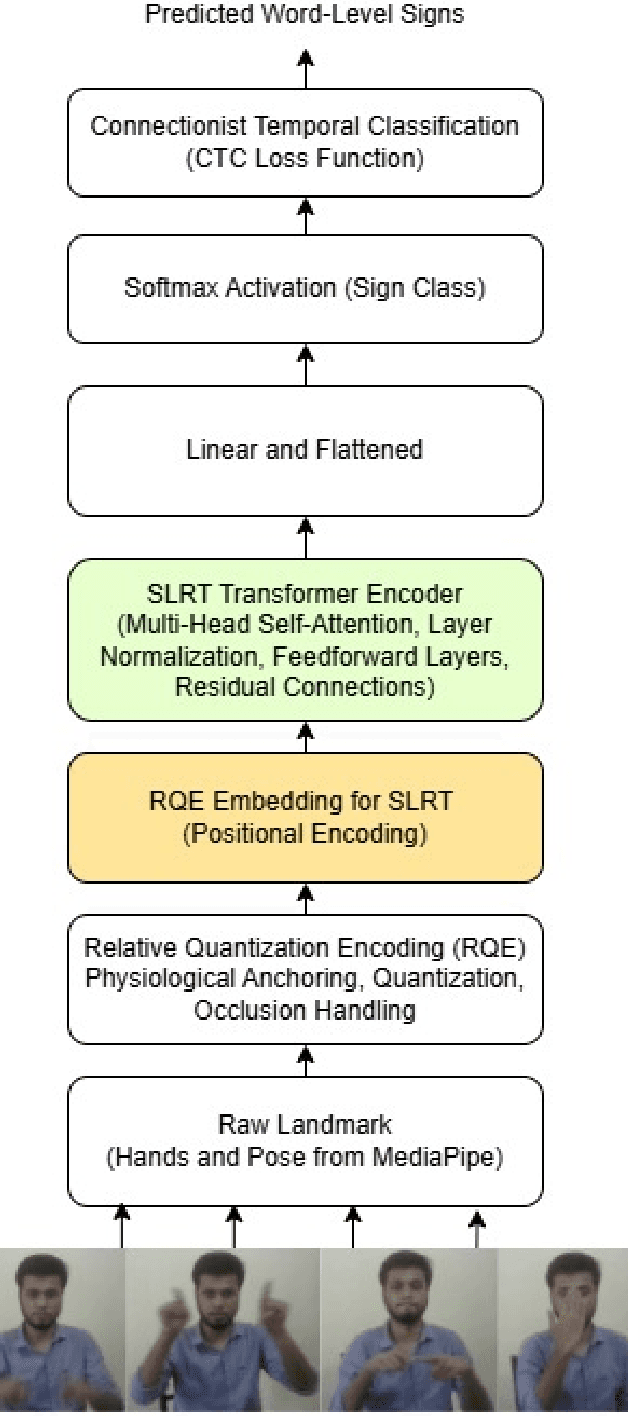

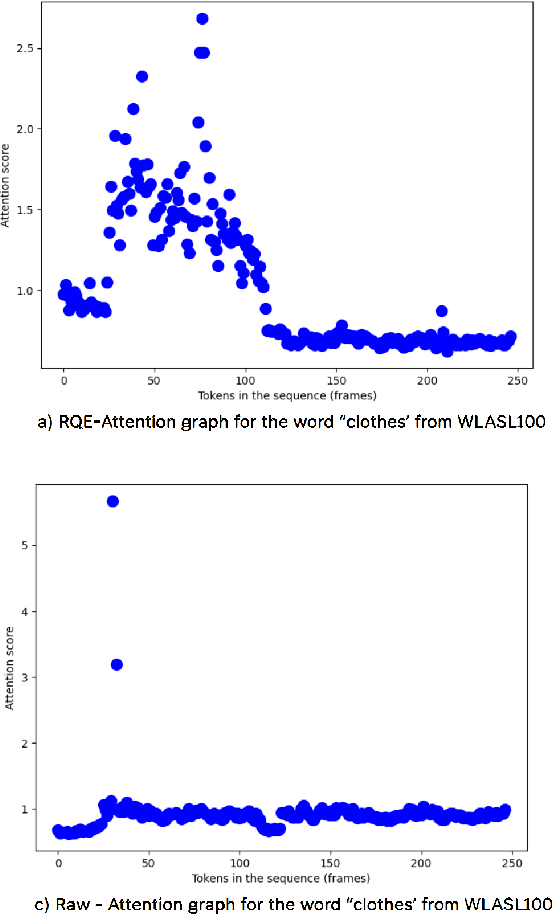

Abstract:Sign language recognition (SLR) for low-resource languages like Bangla suffers from signer variability, viewpoint variations, and limited annotated datasets. In this paper, we present BdSLW401, a large-scale, multi-view, word-level Bangla Sign Language (BdSL) dataset with 401 signs and 102,176 video samples from 18 signers in front and lateral views. To improve transformer-based SLR, we introduce Relative Quantization Encoding (RQE), a structured embedding approach anchoring landmarks to physiological reference points and quantize motion trajectories. RQE improves attention allocation by decreasing spatial variability, resulting in 44.3% WER reduction in WLASL100, 21.0% in SignBD-200, and significant gains in BdSLW60 and SignBD-90. However, fixed quantization becomes insufficient on large-scale datasets (e.g., WLASL2000), indicating the need for adaptive encoding strategies. Further, RQE-SF, an extended variant that stabilizes shoulder landmarks, achieves improvements in pose consistency at the cost of small trade-offs in lateral view recognition. The attention graphs prove that RQE improves model interpretability by focusing on the major articulatory features (fingers, wrists) and the more distinctive frames instead of global pose changes. Introducing BdSLW401 and demonstrating the effectiveness of RQE-enhanced structured embeddings, this work advances transformer-based SLR for low-resource languages and sets a benchmark for future research in this area.
BDA: Bangla Text Data Augmentation Framework
Dec 11, 2024



Abstract:Data augmentation involves generating synthetic samples that resemble those in a given dataset. In resource-limited fields where high-quality data is scarce, augmentation plays a crucial role in increasing the volume of training data. This paper introduces a Bangla Text Data Augmentation (BDA) Framework that uses both pre-trained models and rule-based methods to create new variants of the text. A filtering process is included to ensure that the new text keeps the same meaning as the original while also adding variety in the words used. We conduct a comprehensive evaluation of the framework's effectiveness in Bangla text classification tasks. Our framework achieved significant improvement in F1 scores across five distinct datasets, delivering performance equivalent to models trained on 100\% of the data while utilizing only 50\% of the training dataset. Additionally, we explore the impact of data scarcity by progressively reducing the training data and augmenting it through BDA, resulting in notable F1 score enhancements. The study offers a thorough examination of BDA's performance, identifying key factors for optimal results and addressing its limitations through detailed analysis.
Math Word Problem Solving by Generating Linguistic Variants of Problem Statements
Jun 24, 2023



Abstract:The art of mathematical reasoning stands as a fundamental pillar of intellectual progress and is a central catalyst in cultivating human ingenuity. Researchers have recently published a plethora of works centered around the task of solving Math Word Problems (MWP) $-$ a crucial stride towards general AI. These existing models are susceptible to dependency on shallow heuristics and spurious correlations to derive the solution expressions. In order to ameliorate this issue, in this paper, we propose a framework for MWP solvers based on the generation of linguistic variants of the problem text. The approach involves solving each of the variant problems and electing the predicted expression with the majority of the votes. We use DeBERTa (Decoding-enhanced BERT with disentangled attention) as the encoder to leverage its rich textual representations and enhanced mask decoder to construct the solution expressions. Furthermore, we introduce a challenging dataset, $\mathrm{P\small{ARA}\normalsize{MAWPS}}$, consisting of paraphrased, adversarial, and inverse variants of selectively sampled MWPs from the benchmark $\mathrm{M\small{AWPS}}$ dataset. We extensively experiment on this dataset along with other benchmark datasets using some baseline MWP solver models. We show that training on linguistic variants of problem statements and voting on candidate predictions improve the mathematical reasoning and robustness of the model. We make our code and data publicly available.
BanglaBook: A Large-scale Bangla Dataset for Sentiment Analysis from Book Reviews
May 26, 2023



Abstract:The analysis of consumer sentiment, as expressed through reviews, can provide a wealth of insight regarding the quality of a product. While the study of sentiment analysis has been widely explored in many popular languages, relatively less attention has been given to the Bangla language, mostly due to a lack of relevant data and cross-domain adaptability. To address this limitation, we present BanglaBook, a large-scale dataset of Bangla book reviews consisting of 158,065 samples classified into three broad categories: positive, negative, and neutral. We provide a detailed statistical analysis of the dataset and employ a range of machine learning models to establish baselines including SVM, LSTM, and Bangla-BERT. Our findings demonstrate a substantial performance advantage of pre-trained models over models that rely on manually crafted features, emphasizing the necessity for additional training resources in this domain. Additionally, we conduct an in-depth error analysis by examining sentiment unigrams, which may provide insight into common classification errors in under-resourced languages like Bangla. Our codes and data are publicly available at https://github.com/mohsinulkabir14/BanglaBook.
Venn Diagram Multi-label Class Interpretation of Diabetic Foot Ulcer with Color and Sharpness Enhancement
May 05, 2023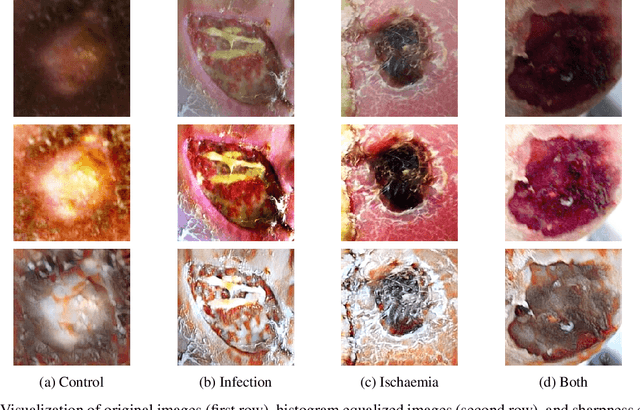
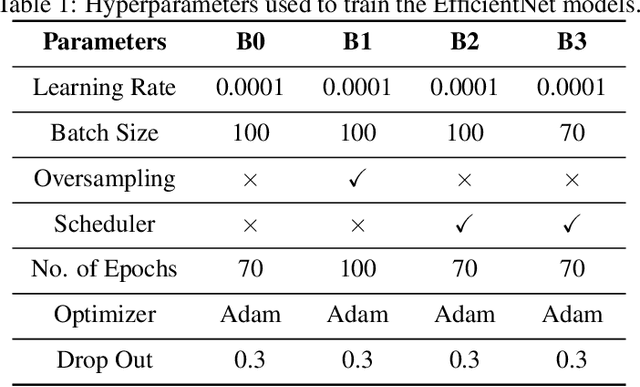
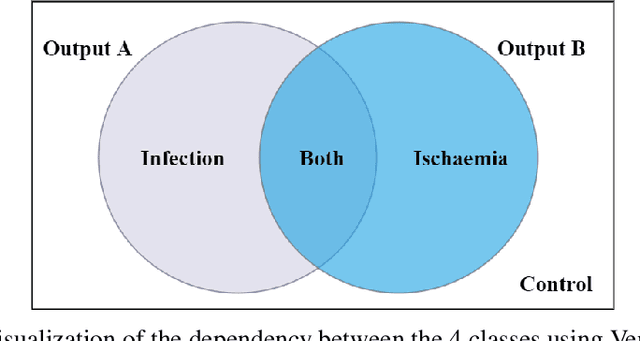
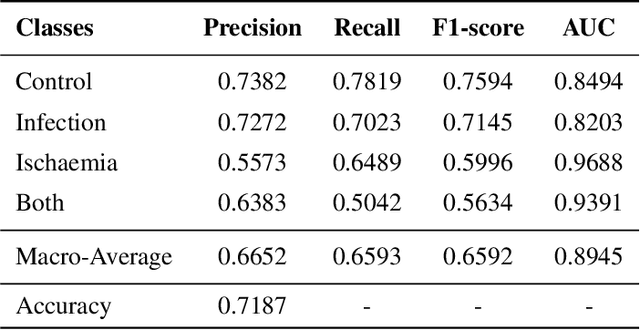
Abstract:DFU is a severe complication of diabetes that can lead to amputation of the lower limb if not treated properly. Inspired by the 2021 Diabetic Foot Ulcer Grand Challenge, researchers designed automated multi-class classification of DFU, including infection, ischaemia, both of these conditions, and none of these conditions. However, it remains a challenge as classification accuracy is still not satisfactory. This paper proposes a Venn Diagram interpretation of multi-label CNN-based method, utilizing different image enhancement strategies, to improve the multi-class DFU classification. We propose to reduce the four classes into two since both class wounds can be interpreted as the simultaneous occurrence of infection and ischaemia and none class wounds as the absence of infection and ischaemia. We introduce a novel Venn Diagram representation block in the classifier to interpret all four classes from these two classes. To make our model more resilient, we propose enhancing the perceptual quality of DFU images, particularly blurry or inconsistently lit DFU images, by performing color and sharpness enhancements on them. We also employ a fine-tuned optimization technique, adaptive sharpness aware minimization, to improve the CNN model generalization performance. The proposed method is evaluated on the test dataset of DFUC2021, containing 5,734 images and the results are compared with the top-3 winning entries of DFUC2021. Our proposed approach outperforms these existing approaches and achieves Macro-Average F1, Recall and Precision scores of 0.6592, 0.6593, and 0.6652, respectively.Additionally, We perform ablation studies and image quality measurements to further interpret our proposed method. This proposed method will benefit patients with DFUs since it tackles the inconsistencies in captured images and can be employed for a more robust remote DFU wound classification.
TextMI: Textualize Multimodal Information for Integrating Non-verbal Cues in Pre-trained Language Models
Mar 29, 2023Abstract:Pre-trained large language models have recently achieved ground-breaking performance in a wide variety of language understanding tasks. However, the same model can not be applied to multimodal behavior understanding tasks (e.g., video sentiment/humor detection) unless non-verbal features (e.g., acoustic and visual) can be integrated with language. Jointly modeling multiple modalities significantly increases the model complexity, and makes the training process data-hungry. While an enormous amount of text data is available via the web, collecting large-scale multimodal behavioral video datasets is extremely expensive, both in terms of time and money. In this paper, we investigate whether large language models alone can successfully incorporate non-verbal information when they are presented in textual form. We present a way to convert the acoustic and visual information into corresponding textual descriptions and concatenate them with the spoken text. We feed this augmented input to a pre-trained BERT model and fine-tune it on three downstream multimodal tasks: sentiment, humor, and sarcasm detection. Our approach, TextMI, significantly reduces model complexity, adds interpretability to the model's decision, and can be applied for a diverse set of tasks while achieving superior (multimodal sarcasm detection) or near SOTA (multimodal sentiment analysis and multimodal humor detection) performance. We propose TextMI as a general, competitive baseline for multimodal behavioral analysis tasks, particularly in a low-resource setting.
A Novel Technique of Noninvasive Hemoglobin Level Measurement Using HSV Value of Fingertip Image
Oct 07, 2019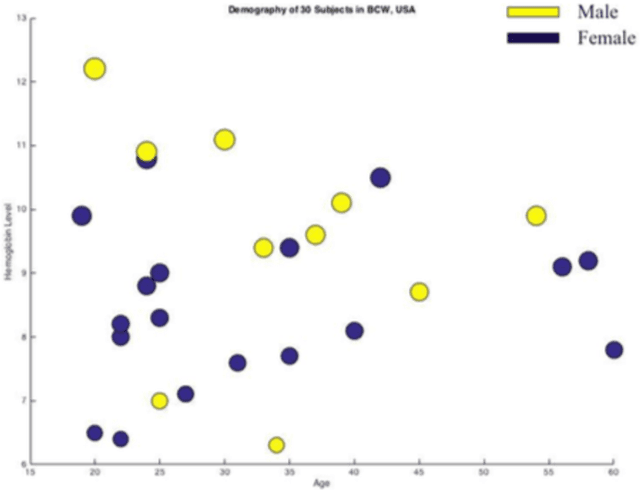
Abstract:Over the last decade, smartphones have changed radically to support us with mHealth technology, cloud computing, and machine learning algorithm. Having its multifaceted facilities, we present a novel smartphone-based noninvasive hemoglobin (Hb) level prediction model by analyzing hue, saturation and value (HSV) of a fingertip video. Here, we collect 60 videos of 60 subjects from two different locations: Blood Center of Wisconsin, USA and AmaderGram, Bangladesh. We extract red, green, and blue (RGB) pixel intensities of selected images of those videos captured by the smartphone camera with flash on. Then we convert RGB values of selected video frames of a fingertip video into HSV color space and we generate histogram values of these HSV pixel intensities. We average these histogram values of a fingertip video and consider as an observation against the gold standard Hb concentration. We generate two input feature matrices based on observation of two different data sets. Partial Least Squares (PLS) algorithm is applied on the input feature matrix. We observe R2=0.95 in both data sets through our research. We analyze our data using Python OpenCV, Matlab, and R statistics tool.
M-BERT: Injecting Multimodal Information in the BERT Structure
Aug 15, 2019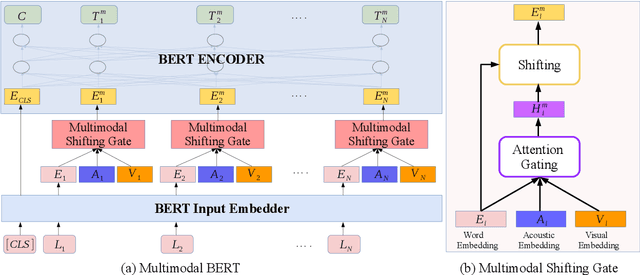
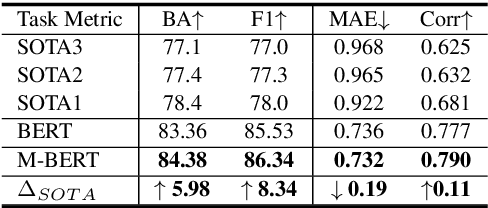
Abstract:Multimodal language analysis is an emerging research area in natural language processing that models language in a multimodal manner. It aims to understand language from the modalities of text, visual, and acoustic by modeling both intra-modal and cross-modal interactions. BERT (Bidirectional Encoder Representations from Transformers) provides strong contextual language representations after training on large-scale unlabeled corpora. Fine-tuning the vanilla BERT model has shown promising results in building state-of-the-art models for diverse NLP tasks like question answering and language inference. However, fine-tuning BERT in the presence of information from other modalities remains an open research problem. In this paper, we inject multimodal information within the input space of BERT network for modeling multimodal language. The proposed injection method allows BERT to reach a new state of the art of $84.38\%$ binary accuracy on CMU-MOSI dataset (multimodal sentiment analysis) with a gap of 5.98 percent to the previous state of the art and 1.02 percent to the text-only BERT.
A Causality-Guided Prediction of the TED Talk Ratings from the Speech-Transcripts using Neural Networks
May 21, 2019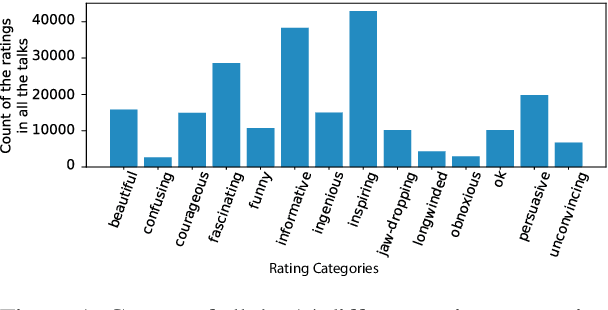
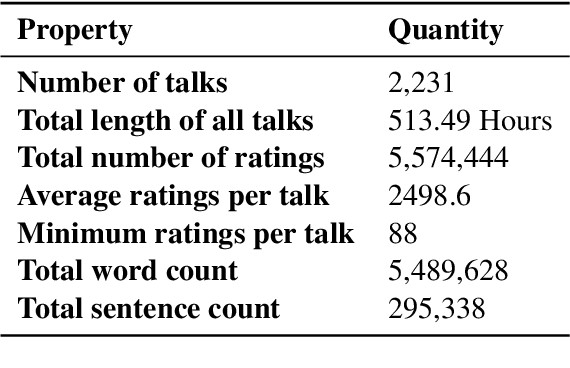
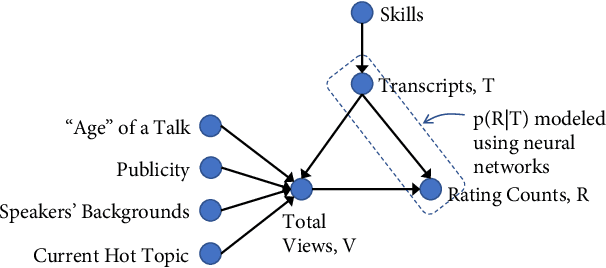
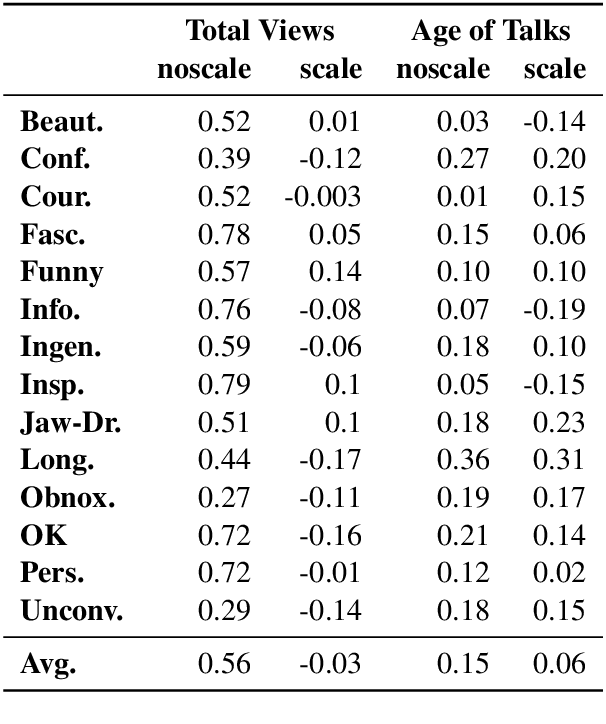
Abstract:Automated prediction of public speaking performance enables novel systems for tutoring public speaking skills. We use the largest open repository---TED Talks---to predict the ratings provided by the online viewers. The dataset contains over 2200 talk transcripts and the associated meta information including over 5.5 million ratings from spontaneous visitors to the website. We carefully removed the bias present in the dataset (e.g., the speakers' reputations, popularity gained by publicity, etc.) by modeling the data generating process using a causal diagram. We use a word sequence based recurrent architecture and a dependency tree based recursive architecture as the neural networks for predicting the TED talk ratings. Our neural network models can predict the ratings with an average F-score of 0.77 which largely outperforms the competitive baseline method.
 Add to Chrome
Add to Chrome Add to Firefox
Add to Firefox Add to Edge
Add to Edge